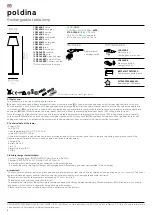
Stabilized Benchtop IR Light Source
Chapter 5: Operation
Rev B, August 4, 2021
Page 11
Chapter 5 Operation
5.1. Starting the Lamp
The front panel of the controller is shown in Figure 4.2. Make sure both the power cable and the lamp control cable
are securely connected, then press power switch (C1) to turn on the lamp.
After the lamp is turned on, the three LEDs on the front panel will show the state of the lamp. Under normal operation
all LEDs will be in GREEN.
Please allow a 45 to 60 minutes warm up period for the lamp to reach a stable state.
CAUTION
The surface of the lamp housing may get hot during operation. The temperature may reach ~60 °C.
Avoid extensive contact with the lamp housing.
5.2. Shutter
The lamp comes with a manual shutter. Simply turn the knob L1 shown in Figure 4.2 clockwise to turn the shutter
into open postion. And turn it counterclockwise to a closed position.
5.3. Stabilized Operation and Monitor Output
The SLS303 has a stabilized operation feature that allows it to retain constant optical output throughout the life
span of the Globar module. However, the output power is NOT user adjustable.
The “Analog Out” port C7 on the pack panel of the controller provides a voltage output that is proportional to the
lamp optical output power. A ~4 V output corresponds to the nominal output light intensity. Any surge or drops in
voltage may indicate that the Globar module is reaching the end of its lifetime or the lamp has a malfunctioned.
5.4. Adjusting Collimation
The front lens L2 shown in Figure 4.2 is pre-adjusted to achieve optimal collimation. The position of the lens can
also be adjusted by the user to change the collimation.
To adjust the collimation lens, loosen the locking ring as shown in Figure 5.1. Turn the lens tube to change the lens
position, clockwise to move closer to bulb, counterclockwise to move further away from Globar module. Once the
desired collimation is achieved, lock the lens back in place.
Figure 5.1 Adjust Collimating Lens Position









































